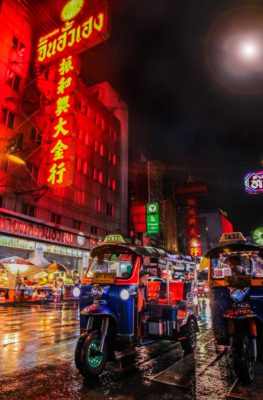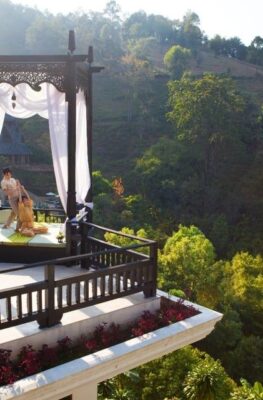Published on January 29, 2016
By: Isabel

I have been to PhuWua Wildlife Sanctuary several times because I love trekking, watching the beautiful sceneries of Isan wild nature and hearing the sounds of the forest. And another reason is I live in a big city where nature is difficult to find.

This time I stayed there two days and Peter, a volunteer from England, came along, excited to discover the territory of some wild elephants and other animals.

Bunloed was glad to welcome us as it is rainy season and only a few tourists go trekking during that time. I have a souvenir of a trekking in PhuWua under a pouring water and also a broken motorbike… not really fun. But we were very lucky because it did not rain at all while we were there.
Bunloed is the owner of 5 lovely bungalows located in the village of Kham Pia. First he built 3 huts with western bathrooms and toilets inside (no hot water but you won’t need it!) and then he added 2 smaller ones without any bathrooms and toilets because he made some in another part of the property. He is very talented in carpentry and DIY and he uses local material only like bamboo and hard wood. He has many ideas and a sure taste in ornament. His garden is beautiful, with a perfectly mowed grass, like on a golf course, and many flowers and fruit trees. And all around are the rice fields with that exceptional green color peculiar to rainy season. A magic place to stay and enjoy Isan country.

Bunloed is also a guide and he took us for a trekking to the point of view of the PhuWuamountains, above the village. Before leaving he prepared some fried rice and cucumbers for the picnic: he is a very good cook too! As he knows I have been several times there, he chose another trail to go and we crossed plantations of rubber trees and a rice field on a wooden bridge before starting to climb in the forest.
We met some farmers in the last plantation of rubber trees and Bunloed borrowed them a tool to show us how to cut the tree to leave the white sap run into a small container at the bottom. The process will be reproduced on the same tree and it will last around 3 and 5 years. In rainy season, when the water is on the top of the rubber in the container, the farmers have to add acid or vinegar to keep the good quality of the rubber. As a result of competition in South East Asia, the value of rubber crashed down and it’s getting more and more difficult for Isan farmers to make a decent living of it.

Biba, Bunloed’s little dog, was running and opening the route in the forest, very brisk when she was hearing a sound and jumping in the direction of it. Bunloed told us that when she was younger she couldn’t walk and run so long like that but now she goes with him everywhere. She is very friendly with everyone and it’s a chance that Bunloed didn’t need a guard dog…
We arrived to the top and had the lunch there, which was very nice. Usually that trekking is done at the end of the afternoon so the tourists can see the sunset and spend the night under the tent. However in rainy season it’s too uncertain and our guide doesn’t any chance about that, which is good.

It was very hot and we were dreaming of bathing in a natural pool that Bunloed had mentioned. We passed several ones but not big enough to swim. Eventually we reached a wider pool and we could cool off and enjoy those moments of relaxation. I was so convinced that it would rain that I didn’t take any sunscreen and I got sunburns while there. A learning experience in Thailand : never expect anything because things can change and it’s the same with the weather.
The downhill was easier, except for the slippery parts where it was adventurous and a work team to go through some tricky crossings.
Bunloed cut some young bamboos to make a soup for the dinner; bamboo shoots soup is a typical dish of Isan and coming from the forest it’s much tastier right?
At night, in the outdoor kitchen and in our bungalows, we had the company of geckos of different sizes. Personally I like them for their funny sounds and because they eat insects such as mosquitoes.
Bunloed knows that “farang” like coconut curries so he made a yellow one with eggplants, pumpkin and mushrooms and I helped him to cook it so I could learn in the same time. I watched also the preparation of the bamboo soup, a dish I like very much.
The next day we went to PhuTok (to the top of the big rock) and we were not the only ones there as it was Mother’s Day. That day is very important in Thailand, it’s a holiday; families gather in schools in the morning for a ceremony and then they eat together and go to visit some places or do some activities. They also put on their houses the blue flag, color of the Queen, as a symbol of respect.
We saw a small snake while we were going down, which was exciting because we heard many noises in the forest but didn’t see any wild animals. That snake is poisonous so we didn’t watch it too closely.

Bunloed was very kind to take us to the bus stop in the town of Bung Kha, 7 km from Kham Pia, to catch the last one to Nongkhai, at 5:30 PM. We bought our tickets but were surprised because we had to sit on the floor as the bus was full (end of Thai holidays) and no one told us about it before. But not the whole travel was in those conditions and we were able to have seats when people were getting off the bus. Another local interesting experience…
I will return to PhuWua (in dry season) and I will stay in a platform tree, one day and one night, to have the chance, maybe… to see some elephants. And I will never forget they are wild ones and they can be dangerous, much more than snakes!
Credit : The Openmind Projects (http://www.openmindprojects.org/)
Openmind Projects is nonprofit education and development organization arranging for overseas volunteer opportunities and providing free training and other support to local people, schools, conservation and other projects in Southeast Asia.






